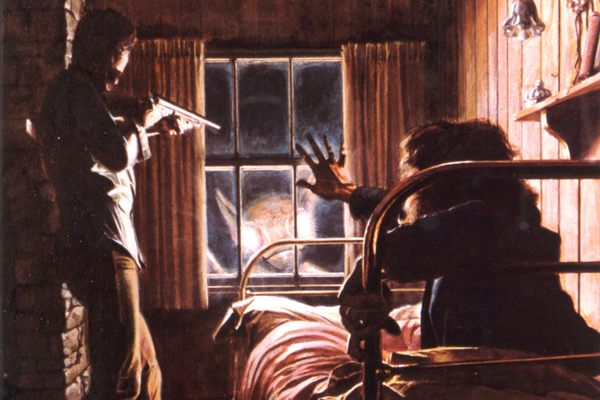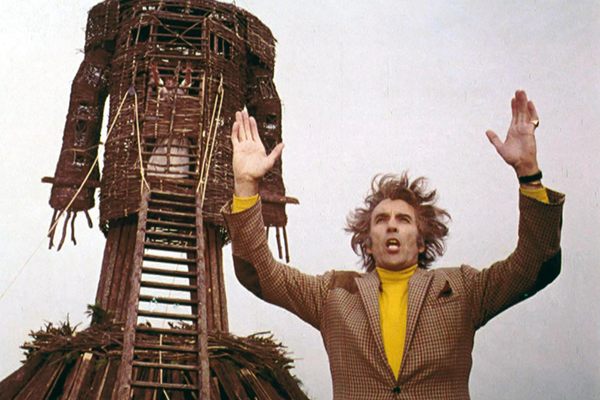The Secrets of Set Decoration from ‘Working Girl’
Staten Island, Wall Street and the story behind Joan Cusack’s hair.

Harrison Ford, Melanie Griffith and Sigourney Weaver in Working Girl. (All Photos: Courtesy 20th Century Fox)
Welcome to “In the Background”, where we discuss what’s going on just behind the protagonists of significant, overlooked, or just plain captivating films. We’re going to examine the set design, costumes, props, and people that populate the world behind famous (or not-so-famous) faces in cinema. For our first installment, we chose the Mike Nichols 1988 fable about women in the workplace, Working Girl. (Spoilers, obviously. )
Mike Nichol’s Working Girl arrived in theaters in December 1988, to largely positive reviews and $4.7 million in ticket sales on its opening weekend. It racked up six Academy Awards nominations, including Best Picture and Best Director, but only took home one, for Best Song; “Let the River Run” by Carly Simon of “You’re So Vain” fame.
The film was first notable for its legendary director (Nichols, of The Graduate fame) and star-packed cast, but its lasting legacy is the striking depiction of office culture and gender roles, as shown through the interiors, both at home and at work.
No detail too small was overlooked in building the parallel worlds of Wall Street and Staten Island, white collar versus working class.
Working Girl tells the Cinderella tale of striver Tess McGill (Melanie Griffith) who wants to break out of office drudgery on Wall Street and stand shoulder to shoulder with the big players. She cooks up a scheme to impersonate her vicious boss, Katherine Parker (Sigourney Weaver), and put together a deal in which she encourages a company called Trask Industries to invest in radio. She does all of this with the help of Parker’s boyfriend, executive Jack Trainer (Harrison Ford), who does not realize he’s working alongside his girlfriend’s secretary.
Would you believe this plot begins to unravel? The film’s cast of notable co-stars includes Joan Cusack, Alec Baldwin, hair, more hair, and sneakers.

Tess (Melanie Griffith) with best friend Cyn (Joan Cusack), and shoulder pads. And hair.
The film opens on a glorious New York City morning as we view the city from across the water of the New York Harbor. We are offered a view of the Ultimate Working Girl, the Statue of Liberty, as well as a lingering shot of the Twin Towers, whose filmic legacy is now emotionally loaded, but which once made nice shorthand for ambition and commerce. (The lobby scenes of the office in which Tess and Katherine work were shot in the World Trade Center.)
Tess is on the Staten Island Ferry on her way to work, and it’s here that the film lets us know right away that she’s a lady of the island trying to make her way in the land of opportunity.
As we join her on the ship, we also get our first glimpse of the lasting visual legacy of Working Girl, the vision of costume designer Ann Roth.

Because Joan Cusack’s character deserves a close-up, if not a whole film, of her own.
Tess and her fellow sailors, clutching newspapers and coffee, are dressed in what will become the film’s key aesthetic: Huge, puffy jackets, audacious brooches, colorful scarves, animal print, swollen shoulder pads, and a sea of stiff, rolling, glorious, towering hair-sprayed hair. Here are workday office drones (many women), dressed for utility, but striving to stand out in their bold ensembles. The perfect specimen of this aesthetic is Tess’ best friend Cyn (Joan Cusack) whose loony coif stands out several inches from her head in a stiff, brunette meringue. Her eyes are ringed in shocking mauve and thick eyeliner, she’s wearing big, green, loopy earrings. It’s nothing short of incredible.
Prior to Working Girl, Roth had already clocked about two decades of costuming work on films such as Midnight Cowboy, The Day of the Locust and Klute and has since accrued over 100 credits. She was a favorite of Nichols, and worked on several of his films, including The Birdcage. She won an Oscar for her work on The English Patient.
“The hair was very exciting to me—you know, it was the big tease,” Roth said in an interview for the book Dressed: A Century of Hollywood Costume Design. “It was the 1980s [with] a Staten Island flavor. They usually don’t come to Manhattan, but those girls who come and work as secretaries, getting off the boat, their shoes would be in their purses…and they were sexy. That’s the point. They were very sexy.”
Sex appeal is on the surface in this film; when Tess arrives at the office she shows off her legs and filmy stockings to the audience as she sits down at her computer and swaps out sneakers for heels.

The working woman’s costume of the 80s, at least on film: suits and sneakers.
Computers take a co-starring role in the film; they pop up in our character’s houses with a lack of subtleness just short of having a spotlight shined on them. It’s 1988, computers have arrived and they mean business.
Tess arrives to work at the fictional Petty Marsh toting a stuffed bunny (stuffed animals are weirdly omnipresent in this film) and a copy of In Search of Excellence: Lessons from America’s Best Run Companies. This 1982 was a bestseller and has gone on to be a hallowed business bible, akin to The 7 Habits of Highly Effective People (which would publish the year after “Working Girl” debuted.) It was entirely likely a person like Tess would own this book in 1988. Written by management consultant Tom Peters, the book examines the practices of 43 U.S. companies. A 2014 Fast Company article reflecting on the legacy of the book called it a “publishing event without precedent in the business world.” It also quotes Peters as saying “This is pretty small beer, but for what it’s worth, okay, I confess: We faked the data.” Peters later told Businessweek that the Fast Company article had put words in his mouth and the data was accurate. Either way, In Search of Excellence is still sold today and billed as “a must-have for the boardroom, business school, and bedside table.”
Here we meet Tess’ new boss, Katherine Parker (Weaver) who sails into the office in pearls, a tweed jacket and hair that—compared to Tess and her ilk—is positively subdued. She immediately pounces on Tess’ stuffed animal, cooing “Great bunny!” Her saccharine tone lets Tess know the compliment isn’t a compliment at all. This solidly places Tess in the realm of the secretarial floor, where the womens’ desks are littered with goofy stress posters, doodads and —yes—stuffed animals.

Tess with stuffed bunny.
The women of the administrative floor are stacked nearly on top of each other—in terms of dress and accommodation, they couldn’t be further from executive Katherine, even though they sit right out her door. Also, remember when we talked about how literal the set decoration is on this film? For office art, Petty Marsh has simply framed large images of money and hung them on the wall. How exactly does Petty Marsh make this money? It’s not really important, but some people have tried to suss it out.

Katherine (Sigourney Weaver) all pearls and perm.
Next we enter Katherine’s expansive office, or, maybe we should call it a lair. Perched on the sill of her window (which has a great view, naturally) is the skull of sabertooth tiger. Totally normal office decor! She probably ordered it from Sky Mall (except that Sky Mall was actually two years away from being founded.) And on the wall hangs a large piece of art depicting big cats.
Make no mistake, Weaver’s thankless (but joyfully executed) task in this film is to be the “bad working woman” to Tess’ good, which is why she did all her shopping at the Aggressive Big Cats Store.

Katherine’s corner office, before she suffers her broken leg.
Inside Katherine’s house, though, gone are the big cats. It’s a ladylike flat—floral prints and pearls rule. Her closet brims with startling amount of taffeta and her bathroom is filled with makeup and spritzes. In a scene where Tess gazes in the mirror as Cyn does her hair, there is a book displayed in the corner. It’s Special Features: Techniques for One-Of-A-Kind Beauty, written by J. Roy Helland, the film’s makeup artist.

Getting dressed at Katherine’s apartment, with a book by the film’s make-up artist in the lower right corner.
It’s in this apartment that Tess learns Katherine has stolen an idea from her and is trying to put a deal together behind her back. Since Katherine is waylaid in a European hospital after breaking her leg in a skiing accident, Tess connives to put the deal together herself, setting up a meeting with executive Jack Trainer (Ford).
Jack’s apartment, of course, is quite masculine. In keeping with the heavy lifting the background decor is doing in this film, elements of Jack’s apartment let us know that he is a Man, especially the curiously large work of art shaped like a beer bottle and labeled “BEER” which would be at home in Moe’s Tavern.

In one of the more absurd scenes of the film, the audience is invited into Katherine’s hospital room, where the vibe is more Alpine Bachelorette Party than institutional, so we can hear her announce to Tess that she is on her way home. Katherine reclines in lingerie slurping champagne, while someone (possibly a nurse) does her nails. A man in full ski garb and an elderly woman make their way through the crowd and stuffed animals once again pop up– a fluffy zebra and a giant gorilla. The jungle theme persists!
Katherine’s elegance is displayed most succinctly in her request for a bottle of Shalimar perfume. Shalimar, with a reputation for sultry elegance, was created by Guerlain in 1921 and has landed a few guest roles, popping up in Auntie Mame”, in the Alan Alda film The Four Seasons and Mad Men.
The schism between Staten Island and Manhattan is the leitmotif of the movie. When Tess gets caught lying to move up the class ladder, she is banished from Manhattan and back on the Staten Island ferry, sailing past the Statue of Liberty once more. It’s the same journey she made in the opening scene now made in disgrace as she’s on her way to pick up her things from the Petty Marsh office. Defeated, she has shed the costume of her business suit and is wearing a sweatshirt, jeans and sneakers. Her fellow secretaries bid her goodbye, and every outfit in this scene is simply amazing. There is not a single wardrobe misstep.

Tess’ fellow secretaries.
By the end of the film, Tess has clawed her way into Manhattan, scoring a job at Trask Industries. She arrives in full office regalia, a uniform she has earned. She now has her own secretary with a poufy bouffant and colorful dress. Her transformation into a Good Witch version of her former boss Katherine is complete.
The camera zooms out of Tess’ new office (where she finally has her own computer), revealing her to be just one of many strivers in a little box of an office in a huge complex surrounded by other office buildings. This is probably supposed to telegraph the grand struggle we all join in together, but is also a tad depressing. It’s just another way the background expresses complicated lessons in bold images.
Bonus:

Yes, that’s Fox Mulder!








Follow us on Twitter to get the latest on the world's hidden wonders.
Like us on Facebook to get the latest on the world's hidden wonders.
Follow us on Twitter Like us on Facebook